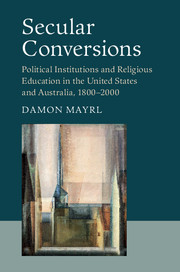 Secular Conversions
Secular Conversions Book contents
- Frontmatter
- Contents
- List of Figures and Tables
- Acknowledgments
- List of Acronyms
- Introduction
- 1 Politics, Institutions, and Secularization
- Part I Forging the nineteenth-century settlement
- Part II The nineteenth-century settlement in transition
- Part III Forging the twentieth-century settlement
- 5 Secularization and the Courts in Postwar America
- 6 Desecularization and Electoral Institutions in Postwar Australia
- Part IV Implications
- Epilogue: Toward a Twenty-First-Century Settlement?
- Index
5 - Secularization and the Courts in Postwar America
from Part III - Forging the twentieth-century settlement
Published online by Cambridge University Press: 05 August 2016
- Frontmatter
- Contents
- List of Figures and Tables
- Acknowledgments
- List of Acronyms
- Introduction
- 1 Politics, Institutions, and Secularization
- Part I Forging the nineteenth-century settlement
- Part II The nineteenth-century settlement in transition
- Part III Forging the twentieth-century settlement
- 5 Secularization and the Courts in Postwar America
- 6 Desecularization and Electoral Institutions in Postwar Australia
- Part IV Implications
- Epilogue: Toward a Twenty-First-Century Settlement?
- Index
Summary
Congress shall make no law respecting an establishment of religion, or prohibiting the free exercise thereof…
The Commonwealth shall not make any law for establishing any religion, or for imposing any religious observance, or for prohibiting the free exercise of any religion, and no religious test shall be required as a qualification for any office or public trust under the Commonwealth.
INTRODUCTION
On 2 March 1898, delegates to Australia's constitutional convention voted to include a section in their new Constitution guaranteeing religious freedom and prohibiting religious establishment. Australia's Section 116 was deliberately modeled on the religion clauses of America's First Amendment in what one Australian legal scholar has termed “a fairly blatant piece of transcription.” Yet despite its nearly identical language, Section 116 has been interpreted vastly differently from its American counterpart. While American courts have read the First Amendment broadly, as creating a “wall of separation” between church and state, the Australian High Court has interpreted Section 116 narrowly, as prohibiting only the “statutory recognition” of a single church. These divergent interpretations have led the courts to play decidedly different roles in defining how secular education would be in each country: while American courts have, since the late 1940s, taken the lead in forging a new secular settlement in education, Australian courts have been only minor players.
Why did the courts play such a central role in the negotiation of America's new secular settlement? In this chapter, I argue that it is because they constituted an accessible institutional target for a concerted, strategic campaign to redefine and nationalize America's religious education policy. In the face of theological division and new ecumenical trends, the divide between Protestants and Catholics that had long structured the politics of religious education began to break down in the mid-twentieth century. At the same time, new players – Jews and civil libertarians – forcefully entered the debate over religion and education in the postwar years. These developments altered the dynamics of religious conflict, destabilizing the established politics of the nineteenth-century settlement and creating room for an assertive campaign for “strict separation” of church and state largely organized by the new players.
- Type
- Chapter
- Information
- Secular ConversionsPolitical Institutions and Religious Education in the United States and Australia, 1800–2000, pp. 159 - 200Publisher: Cambridge University PressPrint publication year: 2016
